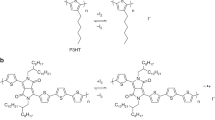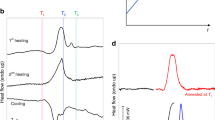Abstract
Nanoresolved doping of polymeric semiconductors can overcome scaling limitations to create highly integrated flexible electronics, but remains a fundamental challenge due to isotropic diffusion of the dopants. Here we report a general methodology for achieving nanoscale ion-implantation-like electrochemical doping of polymeric semiconductors. This approach involves confining counterion electromigration within a glassy electrolyte composed of room-temperature ionic liquids and high-glass-transition-temperature insulating polymers. By precisely adjusting the electrolyte glass transition temperature (Tg) and the operating temperature (T), we create a highly localized electric field distribution and achieve anisotropic ion migration that is nearly vertical to the nanotip electrodes. The confined doping produces an excellent resolution of 56 nm with a lateral-extended doping length down to as little as 9.3 nm. We reveal a universal exponential dependence of the doping resolution on the temperature difference (Tg − T) that can be used to depict the doping resolution for almost infinite polymeric semiconductors. Moreover, we demonstrate its implications in a range of polymer electronic devices, including a 200% performance-enhanced organic transistor and a lateral p–n diode with seamless junction widths of <100 nm. Combined with a further demonstration in the scalability of the nanoscale doping, this concept may open up new opportunities for polymer-based nanoelectronics.
This is a preview of subscription content, access via your institution
Access options
Access Nature and 54 other Nature Portfolio journals
Get Nature+, our best-value online-access subscription
$29.99 / 30 days
cancel any time
Subscribe to this journal
Receive 12 print issues and online access
$259.00 per year
only $21.58 per issue
Buy this article
- Purchase on Springer Link
- Instant access to full article PDF
Prices may be subject to local taxes which are calculated during checkout





Similar content being viewed by others
Data availability
The relevant raw data for this study are available for research purposes from the corresponding authors upon reasonable request. Source data are provided with this paper.
Code availability
The code that supports the theoretical plots within this paper is available from the corresponding authors upon reasonable request.
References
Zheng, Y. Q. et al. Monolithic optical microlithography of high-density elastic circuits. Science 373, 88–94 (2021).
Kim, M. J. et al. Completely foldable electronics based on homojunction polymer transistors and logics. Sci. Adv. 7, eabg8169 (2021).
Perevedentsev, A. & Campoy-Quiles, M. Rapid and high-resolution patterning of microstructure and composition in organic semiconductors using ‘molecular gates’. Nat. Commun. 11, 3610 (2020).
WICK, G. L. Ion implantation. Science 170, 425–427 (1970).
Shinada, T., Okamoto, S., Kobayashi, T. & Ohdomari, I. Enhancing semiconductor device performance using ordered dopant arrays. Nature 437, 1128–1131 (2005).
Sviridov, D. V. Chemical aspects of implantation of high-energy ions into polymeric materials. Russ. Chem. Rev. 71, 315–327 (2002).
Moliton, A., Lucas, B., Moreau, C., Friend, R. H. & François, B. Ion implantation in conjugated polymers: mechanisms for generation of charge carriers. Philos. Mag. B 69, 1155–1171 (2006).
Popok, V. Ion implantation of polymers: formation of nanoparticulate materials. Rev. Adv. Mater. Sci. 30, 1–26 (2012).
Jacobs, I. E. et al. Reversible optical control of conjugated polymer solubility with sub-micrometer resolution. ACS Nano 9, 1905 (2015).
Bedolla et al. Reversible doping and photo patterning of polymer nanowires. Adv. Electron. Mater. 6, 2000469 (2020).
Jacobs, I. E. et al. Direct-write optical patterning of P3HT films beyond the diffraction limit. Adv. Mater. 29, 1603221 (2017).
Berggren, M. & Malliaras, G. G. How conducting polymer electrodes operate. Science 364, 233 (2019).
Kawasaki, M. & Iwasa, Y. ‘Cut and stick’ ion gels. Nature 489, 510–511 (2012).
Rivnay, J. et al. Organic electrochemical transistors. Nat. Rev. Mater. 3, 17086 (2018).
Ishiguro, Y., Inagi, S. & Fuchigami, T. Site-controlled application of electric potential on a conducting polymer ‘canvas’. J. Am. Chem. Soc. 134, 4034–4036 (2012).
Borgwarth, K., Rieken, C.Ebling, D. G. & Heinze, J. Surface characterisation and modification by the scanning electrochemical microscope (SECM). Phys. Chem. 99, 1421–1426 (1995).
Bargigia, I., Savagian, L. R., Osterholm, A. M., Reynolds, J. R. & Silva, C. Charge-transfer intermediates in the electrochemical doping mechanism of conjugated polymers. J. Am. Chem. Soc. 143, 294–308 (2021).
Bischak, C. G., Flagg, L. Q. & Ginger, D. S. Ion exchange gels allow organic electrochemical transistor operation with hydrophobic polymers in aqueous solution. Adv. Mater. 32, e2002610 (2020).
Vyazovkin, S. & Dranca, I. Physical stability and relaxation of amorphous indomethacin. J. Phys. Chem. B 109, 18637–18644 (2005).
Aziz, S. B., Woo, T. J., Kadir, M. F. Z. & Ahmed, H. M. A conceptual review on polymer electrolytes and ion transport models. J. Sci. Adv. Mater. Dev. 3, 1–17 (2018).
Zhao, Q., Stalin, S., Zhao, C.-Z. & Archer, L. A. Designing solid-state electrolytes for safe, energy-dense batteries. Nat. Rev. Mater. 5, 229–252 (2020).
Bresser, D., Lyonnard, S., Iojoiu, C., Picard, L. & Passerini, S. Decoupling segmental relaxation and ionic conductivity for lithium-ion polymer electrolytes. Mol. Syst. Des. Eng. 4, 779–792 (2019).
Wang, Y. et al. Decoupling of ionic transport from segmental relaxation in polymer electrolytes. Phys. Rev. Lett. 108, 088303 (2012).
Ratner, M. A. & Shriver, D. F. Ion transport in solvent-free polymers. Chem. Rev. 88, 109–124 (1988).
Andersson Ersman, P. et al. All-printed large-scale integrated circuits based on organic electrochemical transistors. Nat. Commun. 10, 5053 (2019).
Tanaka, H. et al. Thermoelectric properties of a semicrystalline polymer doped beyond the insulator-to-metal transition by electrolyte gating. Sci. Adv. 6, eaay8065 (2020).
Zeiner, C. et al. Atypical self-activation of Ga dopant for Ge nanowire devices. Nano Lett. 11, 3108–3112 (2011).
Kanungo, P. D. et al. Ex situ n and p doping of vertical epitaxial short silicon nanowires by ion implantation. Nanotechnology 20, 165706 (2009).
Wang, G. et al. Seamless lateral graphene p–n junctions formed by selective in situ doping for high-performance photodetectors. Nat. Commun. 9, 5168 (2018).
Utama, M. I. B. et al. A dielectric-defined lateral heterojunction in a monolayer semiconductor. Nat. Electron. 2, 60–65 (2019).
Liu, J. et al. N-type organic thermoelectrics of donor–acceptor copolymers: improved power factor by molecular tailoring of the density of states. Adv. Mater. 30, e1804290 (2018).
Ghasemi, M. et al. A molecular interaction–diffusion framework for predicting organic solar cell stability. Nat. Mater. 20, 525–532 (2021).
Venkateshvaran, D. et al. Approaching disorder-free transport in high-mobility conjugated polymers. Nature 515, 384–388 (2014).
Frisch, M. J. et al. Gaussian 16, revision C.01 (2016).
Acknowledgements
The authors acknowledge financial support from the National Natural Science Foundation (22125504, 22021002, 22305253, U22A6002), the Strategic Priority Research Program of the Chinese Academy of Sciences (XDB0520000), the Beijing Municipal Natural Science Foundation (Z220025), the K. C. Wong Education Foundation (GJTD-2020-02), the China Postdoctoral Science Foundation (119103S395), Fundamental Research Funds for the Central Universities (E1E40301X2, E2E40305X2), CAS (ZDBS-LYSLH034). We thank W. Zhang and I. Mcculloch (Imperial College London) for providing the PBTTT polymers. We appreciate J. Jiang (Institute of Chemistry, Chinese Academy of Sciences) for the valuable discussion on the mechanism part. The work in Mons has received funding from the European Union’s Horizon 2020 research and innovation programme under grant agreement number 964677 (MITICS) and computational resources have been provided by the Consortium des Équipements de Calcul Intensif (CÉCI), funded by the Fonds de la Recherche Scientifique de Belgique (FRS-FNRS) under grant number 2.5020.11 and by the Walloon Region. D.B. is FNRS Research Director.
Author information
Authors and Affiliations
Contributions
C.D. and F.Z. conceived and led the research. D.Z. supervised the project. C.D., L.X., F.Z. and Z.H. proposed the concept and designed the experiments. L.X. did the device fabrication, measurements, analysed the data and performed the simulations. C.D. and L.X. wrote the main manuscript with comments from all authors. C.Y. measured the Tg of semiconductors and performed the grazing-incidence wide-angle X-ray scattering experiments. Y. Zhao performed the time-of-flight secondary ion mass spectrometry measurements. Z.L. performed the infrared temperature measurements. Y.M. commented on the organization of the manuscript. Z.J. helped with the lithography process for the electrode pattern. V.L. and D.B. performed the infrared simulation of the charged polymer. Q.M. and L.J. helped with electrochemical doping. L.L. helped with scanning electron microscopy/energy-dispersive spectroscopy measurements. X.D. performed X-ray and ultraviolet photoelectron spectroscopy measurements and DFT calculations. Y. Zou helped with the X-ray and ultraviolet photoelectron spectroscopy analysis. D.Z. guided the synthesis of PNDI2TEG-2Tz polymer and commented on the manuscript. All authors contributed to the preparation of the final draft.
Corresponding authors
Ethics declarations
Competing interests
The authors declare no competing interests.
Peer review
Peer review information
Nature Nanotechnology thanks Ying Diao and the other, anonymous, reviewer(s) for their contribution to the peer review of this work.
Additional information
Publisher’s note Springer Nature remains neutral with regard to jurisdictional claims in published maps and institutional affiliations.
Extended data
Extended Data Fig. 1 Determination of the electrolyte Tg.
a-c, Differential scanning calorimeter thermal analysis curves of (a), PMMA/EMIM-TFSI, (b), PVDF-HFP/EMIM-TFSI and (c), PEO/EMIM-TFSI electrolytes with different weight ratio of EMIM-TFSI ionic liquid. The determination of electrolyte Tg was shown in the figure by extracting the midpoint between rubber and glass baselines. d, Comparison of the glass transition temperature these three electrolytes with varying weight ratio of EMIM-TFSI. Data are presented as mean ± standard error from 3 uncertain values in fitting of the DSC curve.
Extended Data Fig. 2 Doping depth analysis of the films with different electrolyte Tg values.
a, TOF-SIMS profiles of the TFSI− and SiO2 signals as a function of sputtering time. The thickness of the films was 100 nm and were doped under different electrolyte Tg values. b, 3D tomography images of TFSI− anion in the PBTTT film that constructed from the depth profiles of graph (a). The blue and green points represent the distribution of TFSI− anion and SiO2 substrate, respectively. It can be observed that the TFSI− dopant existed within the whole thickness of 100 nm for all electrolyte Tg, although the injected ion dose decreased at the high electrolyte Tg.
Extended Data Fig. 3 Determination of the contact size (Lc) between AFM tip and electrolyte.
a, Schematic illustration of the contact between the AFM tip and electrolyte. Given the soft nature of the electrolyte, regular hollows on the electrolyte would be induced by the AFM tip that could be used to estimate the contact area between the tip and electrolyte. b, AFM height image of the PMMA/EMIM-TFSI (10%) electrolyte surface after NEII doping. c, Height profiles of the hollow array, which are derived from 9 sites as depicted in graph (b). d, Statistical distribution histograms of Lc (left) and Dc (right). The Dc means the depth of the hollow. All data are presented as mean ± standard error from 9 values that extracted from the hollows.
Supplementary information
Supplementary Information
Supplementary Note 1, Table 1, Figs. 1–36 and references.
Source data
Source Data Fig. 1
Source data for Fig. 1 are in sheet 1. Source Data Fig. 2 Source data for Fig. 2 are in sheet 2. Source Data Fig. 3 Source data for Fig. 3 are in sheet 3. Source Data Fig. 4 Source data for Fig. 4 are in sheet 4. Source Data Fig. 5 Source data for Fig. 5 are in sheet 5.
Source Data Extended Data Fig./Table 1
Source data for extended data Fig. 1 are in sheet 1. Source Data Extended Data Fig./Table 2 Source data for extended data Fig. 1 are in sheet 2. Source Data Extended Data Fig./Table 3 Source data for extended data Fig. 1 are in sheet 3.
Rights and permissions
Springer Nature or its licensor (e.g. a society or other partner) holds exclusive rights to this article under a publishing agreement with the author(s) or other rightsholder(s); author self-archiving of the accepted manuscript version of this article is solely governed by the terms of such publishing agreement and applicable law.
About this article
Cite this article
Xiang, L., He, Z., Yan, C. et al. Nanoscale doping of polymeric semiconductors with confined electrochemical ion implantation. Nat. Nanotechnol. (2024). https://doi.org/10.1038/s41565-024-01653-x
Received:
Accepted:
Published:
DOI: https://doi.org/10.1038/s41565-024-01653-x



